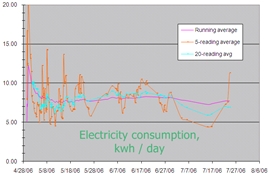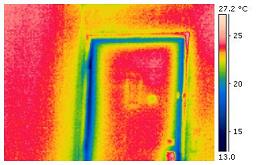What do we mean?
Maybe you’re like me and you’re on a never-ending quest for the energy efficient home – or the most energy efficient house your money and elbow grease can buy.
(It seems that no matter how many energy efficiency measures I carry out in my house, I’m always after more. It’s like eating potato chips with salt and vinegar – I can’t stop!)
Or maybe you’re not interested in squeezing every drop of energy efficiency out of your home, you just want a quick way to save a few bucks and eliminate wasteful consumption.
Either way, you might want an idea of what a truly energy efficient home can be, before you choose how far to go.
You can start from either an absolute or a relative position. From an absolute perspective, the most energy efficient home is one that produces more energy than it consumes, over its lifetime.

I charted my electricity consumption when I started finding ways to cut
You would probably include not only your home’s daily or annual energy consumption (electricity, natural gas and other energy sources), but the energy used to create the construction materials, to deliver the materials to the site, and to assemble them. You might include the energy used to dispose of the house in the future, if you’re a complete purist. (Is there such a thing as a partial purist!?)
These homes are often called ‘zero energy homes’. And yes, they do exist. They are being built by the dozens and by the hundreds in forward-thinking countries like Denmark and Germany. They are heated almost entirely with solar or geothermal energy, lit during the daytime using mostly passive solar lighting (windows, sun tubes), and what extra energy they need is produced from photovoltaic solar cells or wind turbines or biogas; if all goes well, the solar cells or turbines pump extra electricity back into the electrical grid.
The relative perspective is more achievable: instead of striving for the energy efficient home you can strive for an energy efficient home – one that is more energy efficient than at least half the homes in your country or region.
An easy way to achieve better-than-average energy savings in your home is to find out what your neighbors, living in similar houses, pay in annual utility costs. If you’re new to a neighborhood, utility costs can be a great conversation starter, and the prior owner of your house may be willing to provide copies of utility bills, either before or after the sale closes.
Once you know what the ‘competition’ is, start measuring your own usage, by checking your utility bills after a few months. Even better, if you have copies of the previous owner’s bills, or your utility company can provide past usage information, read the electrical and gas meters for your house several times a month to see if your average daily consumption is above or below your predecessor’s.
If you’re paying substantially more than your neighbors, you may have a single obvious inefficiency (an old, inefficient furnace, an air conditioner in need of a tune-up, hollow exterior walls), or you may just be taking longer showers! It pays to find out.
If you’re using substantially more than the prior owners, then either they lived a more energy efficient lifestyle, (maybe they didn’t use air conditioning, or kept the house a frigid 60F in winter) or you’ve introduced some inefficiency. For example you may be leaving windows open when the heat or AC is on, or leaving appliances plugged in that are constantly drawing current. Maybe the furnace filter is clogged up or you forgot to take the cover off the air conditioner when the weather got hot!
For any situation like those above, unless there’s an easy, quick, and obvious solution, get a home energy audit as soon as you can – before you start tinkering with improvements – and take things from there. If you stack up well against your neighbors, or the previous owner, you’re off to a good start. I would still suggest hiring a professional to do a home energy audit, but it’s not as critical.

Air leak around doorframe (infrared)>
I always recommend an audit if your efficiency upgrades are eligible for home energy retrofit tax credits or grants. In that case you should always have the home energy audit done before doing anything major (or even something trivial but helpful like caulking your window trim and baseboards), because the credits or grants often more than cover the cost of the audit.
My-Green-Home-Project.com has an excellent example of a real energy audit, complete with detailed photos and a sample energy audit report.
Your local or national government may also publish statistics on average energy consumption for a given family size and house type. Some figures for annual household electrical usage for different countries or regions (results are not all for the same year) include:
- Canada: 12,836 kWh per year (ours was 3,030 in 2007!)
- US: 10,654 kWh per year
- Europe: 4,667 kWh per year
- Japan: 5,945 kWh per year
For the US, natural gas consumption averages 704 CCF (hundred cubic feet) per household. Natural gas rates are highly impacted by climate, as the primary use of natural gas in cold climates is for home heating.
Once you know what is typical for your neighborhood, country, or region, you’ll find it easier to decide how far you can realistically go. A zero-energy home is probably not an option unless you’re willing to tear down what you have today and rebuild from scratch. But it is possible to have the most energy efficient home in your neighborhood with a proper assessment of your home’s energy efficiency today, the right knowledge, and a bit of money and hard work.

Many American homes are poorly insulated and have old HVAC systems that waste energy.
Get your house properly insulated and upgrade the HVAC.
That will get you closer to an energy efficient home.
Couldn’t agree more! And I’d say further, before you get your house insulated and ugrade the HVAC:
See my article on high efficiency heat pumps for more information.